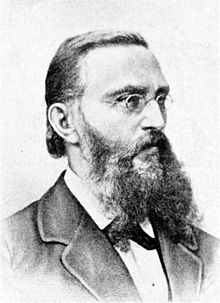Carl Philipp Euler
Carl Philipp Euler (born February 8, 1828 in Kirchenbollenbach (today Idar-Oberstein ), † September 15, 1901 in Berlin ) was a German gymnastics teacher and writer.
Life
Euler was the younger son of the superintendent Adolf Euler and his wife Sophie Elisabeth, a daughter of the court chaplain Friedrich Wilhelm Spener . The future engineer Carl Friedrich Euler was his older brother, through his mother Euler was related to the theologian Philipp Jakob Spener .
In 1848 Euler began to study philology and history at the University of Bonn ; It is not guaranteed whether he met the theologian Gottfried Kinkel there. In 1848 he joined the Bonn Wingolf (then Germania). Together with Friedrich Albert Lange , Euler soon became a committed member of the Academic Gymnastics Club .
After completing his military service as a one-year volunteer , Euler moved to Berlin University with the same subjects . There - according to his own statements - a seminar of the Central Gymnastics Institute was one of his most important from 1852 to 1853 . In 1854 Euler was able to successfully complete his studies with a doctorate .
In the same year Euler got a job as a gymnastics teacher at the Pforta State School in Bad Kösen . He was soon able to make a name for himself there, by restructuring the physical education lessons, including the latest findings, also with regard to swimming lessons. In 1860 Euler was promoted and appointed as a lecturer at the Central Gymnasium. Here Euler was the trigger for the parallel bars dispute , because he wanted to reintegrate high bar and parallel bars into the practice routine, which Hugo Rothstein had abolished,
In 1860 Euler married Sophie, a daughter of Superintendent Tischer from Jerxheim ( Duchy of Braunschweig ) in Berlin . With her he had two daughters and two sons.
In 1872 Euler was appointed full professor , and when the gymnastics teacher training institute was created five years later , Euler was appointed as a teaching director to direct it. In addition to these tasks taught Euler students at various Berlin schools, but also a teacher at the School Teacher and school teachers seminar .
In 1892 Euler reached the high point of his career when he was appointed to the school board . From 1895, Euler gradually resigned from his offices and retired into private life. At the age of 73 he died after a brief illness on September 15, 1901 in Berlin.
Euler was largely responsible for the reintroduction of "German gymnastics" ( apparatus gymnastics ). He was against the "Swedish gymnastics" (among others by Hugo Rothstein ), the parallel bars , horizontal bar and the like. a. refused. Euler also supported the theories of Adolf Spieß from the start , who vehemently advocated physical education for girls . Euler also campaigned for this in the Central Committee for the Promotion of Youth and Popular Games . Euler also set the trend by integrating swimming lessons in schools. He tried u. a. also to meet the requirements of Friedrich Ludwig Jahn and Ernst Wilhelm Bernhard Eiselen .
Fonts
- (with Gebhard Eckler ): Regulations and official announcements concerning the gymnastics in Prussia. Leipzig 1869.
- (with Hermann Otto Kluge ): Textbook of the art of swimming for gymnasts and other friends of physical exercise and for use in schools and military swimming facilities. Berlin 1870.
- (with Hermann Otto Kluge): Gym equipment and gymnastics equipment for school and military gymnastics institutions and gymnastics clubs. Berlin 1872.
- The Jahndenkmal. Leipzig 1874.
- The lesson in gymnastics. (Revised from Diesterweg's guide ) Essen 1878.
- The history of physical education. In: Karl Kehr : History of the method. Gotha 1880.
- Friedrich Ludwig Jahn. His life and work. Stuttgart 1881.
- Friedrich Friesen . Berlin 1885.
- Encyclopedic Handbook of All Gymnastics and Allied Areas. Vienna 1894–1896.
- The German art of gymnastics according to FL Jahn and Ernst Eiselen as a guide for aspiring gymnastics teachers and for self-teaching. With a precise explanation of the gymnastics equipment and 22 illustrations of the same. Anhuth, Danzig 1840.
literature
- Grete Ronge: Euler, Carl Philipp. In: New German Biography (NDB). Volume 4, Duncker & Humblot, Berlin 1959, ISBN 3-428-00185-0 , p. 687 f. ( Digitized version ).
Web links
- Literature by and about Carl Philipp Euler in the catalog of the German National Library
Individual evidence
- ↑ Complete directory of Wingolf, Lichtenberg 1991
- ↑ Arnd Krüger : History of movement therapy. In: Preventive Medicine. ( Loose-leaf collection ) Springer, Heidelberg 1999, 07.06, pp. 1–22.
| personal data | |
|---|---|
| SURNAME | Euler, Carl Philipp |
| ALTERNATIVE NAMES | Euler, Carl (common attribution) |
| BRIEF DESCRIPTION | German gymnastics teacher and writer |
| DATE OF BIRTH | February 8, 1828 |
| PLACE OF BIRTH | Kirchenbollenbach (today Idar-Oberstein ) |
| DATE OF DEATH | September 15, 1901 |
| Place of death | Berlin |
